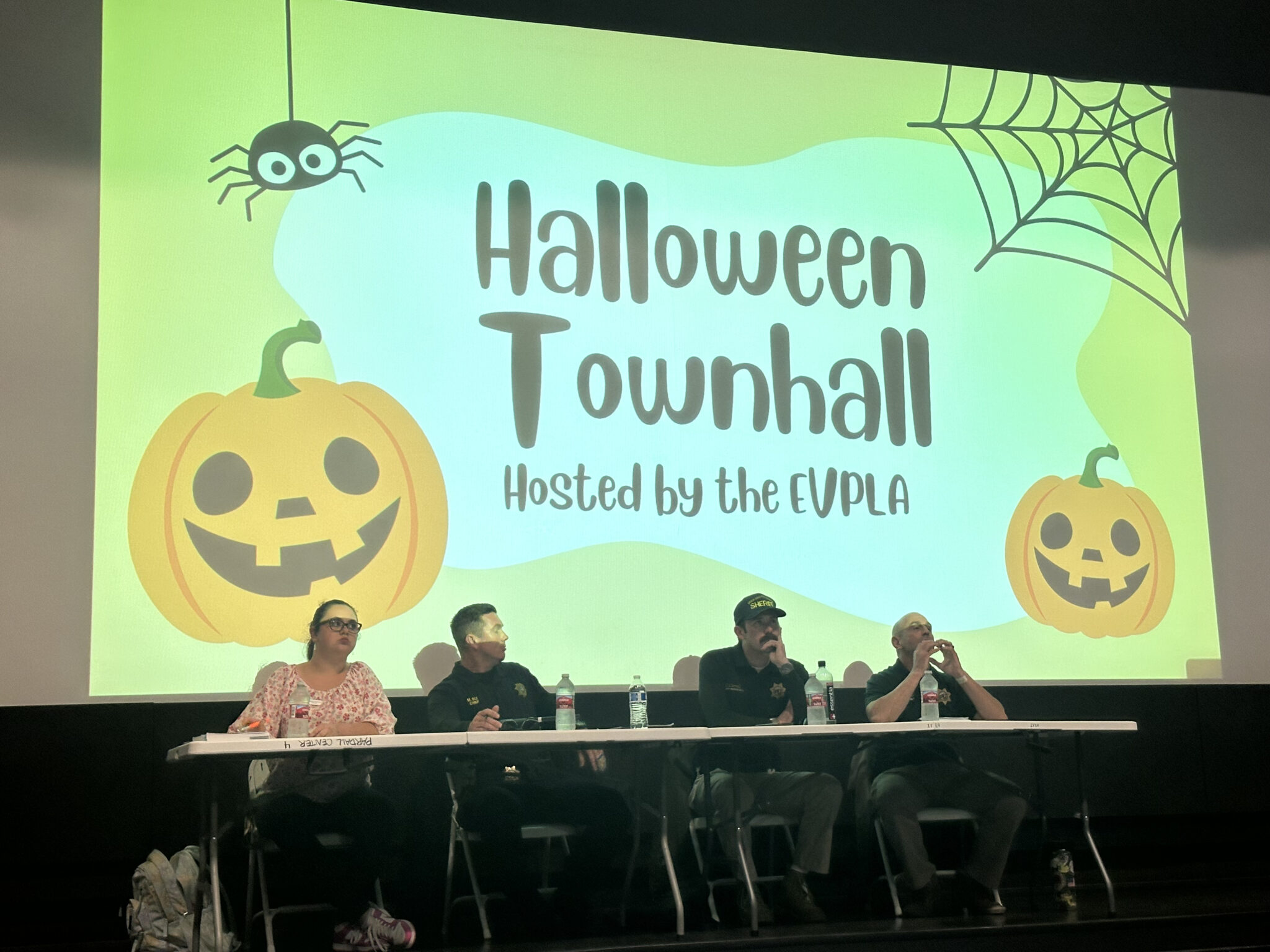The annual noise ordinance ahead of Halloween went into effect on Oct. 26. The Associated Students Office of the External Vice President for Local Affairs and other local entities hosted a town hall the previous Wednesday to hear questions and concerns from residents.

Panelists of the town hall answered questions through an anonymous Google form or directly from attendees in the audience. Jack Dindia / Daily Nexus
Every year, Isla Vista Foot Patrol (IVFP) enforces a noise ordinance from Oct. 26 to Nov. 4 to minimize the effects of a large-scale Halloween celebration, including increased crime reports and littering. From 6 p.m. to 7 a.m., no amplified music or loud noises can be heard from 100 feet of each property. Town hall attendees primarily asked questions regarding the parameters and effect of the ordinance and law enforcement’s priorities and protocol.
Panelists of the town hall answered questions through an anonymous Google Form and directly from attendees in the audience. The panel included IVFP Lieutenant Joe Schmidt, IVFP Community Resource Deputy Colby Carrell, UC Police Department (UCPD) Interim Chief of Police Matthew Bly and Isla Vista Community Services District (IVCSD) Director Katherine Carmichael. External Vice President for Local Affairs (EVPLA) and third-year political science major E.J. Raad moderated the town hall.
The first half of the panel was reserved for questions submitted electronically. When asked what the priorities of law enforcement were during Halloween, Schmidt answered that the IVFP and UCPD would focus on holding a “safe event” by sufficiently staffing police officers.
“There will be up staffing of deputy sheriffs and UCPD officers in Isla Vista, in multiple teams to cover as much ground as possible, so we have enough resources to respond to calls for service and the anticipated increase in crowds,” Schmidt said.
Bly also informed attendees of alternative Halloween events residents can participate in, in addition to UC Santa Barbara’s “Hallowheels” event and a men’s soccer game.
The next question was regarding the history of the noise ordinance on Halloween, which dates all the way back to the 1990s, when Halloween was an “extremely destructive event,” according to Schmidt.
“Historically, there were numerous violent crimes, sexual assaults, cliff falls,” Schmidt said. “I don’t know the number of how many people have died, but I know there were fatalities in the duration of Halloween when it was unmanaged by the festival ordinance.”
According to IVCSD General Manager Jonathan Abboud, who was present at the town hall, the ordinance was established in 1993. Daily Nexus coverage of the 1992 Halloween weekend states that 40,000 people were in Isla Vista on Halloween night. Over 1,000 people were arrested over the entire weekend and two people were in critical condition after falling from the Del Playa Drive cliffs. Yet, “the weekend was considered a success from a law enforcement standpoint,” according to then-Santa Barbara County Sheriff’s Department Public Information Officer Tim Gracey.
As far as how students can hold police accountable, Schmidt directed anyone who feels wronged by law enforcement to file a formal complaint through the Santa Barbara County Sheriff’s Office (SBSO). Bly also directed students to utilize the UCPD Police Accountability Board, which serves as the primary go-between for students and UCPD.
Regarding whether data supports the claim that a noise ordinance decreases the number of medical incidents over the years, Schmidt clarified that he doesn’t have that data. While he can’t say with certainty how large the crowds currently get for Halloween, he said they used to have crowds of 30,000 to 40,000 people, and “logically speaking,” the medical calls have gone down due to the lower turnout.
Another attendee also asked if there is a better “feasible option” to allow I.V. residents to party during this weekend while simultaneously preventing out-of-towners from “ruining it” for locals. Schmidt emphasized that non-locals don’t have “the same love and respect for this amazing place,” and that while he is open to suggestions, he doesn’t see a “logistically possible way” to facilitate a normal weekend in I.V. while preventing out-of-towners from visiting.
“Some suggestions I’ve heard were ‘Let’s just seal off Isla Vista and only allow people who live here.’ That’s not logistically possible, nor is it constitutional. That would mean setting up roadblocks in Isla Vista, as it stands, is too porous. There’s too many ways for people to get in. So it’s just not a feasible option,” Schmidt said. “I work at 6504 Trigo road, down the street there, Tuesday through Friday. If somebody has a better idea, I’m all ears.”
Multiple attendees asked whether restorative justice (RJ) would be in place during the ordinance, which is a program where students can get nonviolent misdemeanor charges removed from their record by taking classes and participating in community service. Carrell clarified that RJ will be canceled both Friday and Saturday within the ordinance, since violating the ordinance is “inherently against the ethos of restorative justice.”
Raad proceeded to take questions from the audience. The first attendee inquired about a safety tip in an Oct. 20 campus-wide email sent by UCSB Student Life. The email stated that students should “not carry any props with [their costumes]; officers will confiscate anything that could be potentially used as a weapon.”
Schmidt acknowledged that, although the email didn’t come from the IVFP, the tip was “vague” and that law enforcement was mainly focused on checking replica firearms instead of all props.
Another attendee asked how I.V. residents can support law enforcement and firefighters during the Halloween weekend. Bly said that voicing your opinion at events such as this one is important and reminded the audience to “keep things local as much as possible.” Bly also encouraged people to comply with law enforcement orders when ambulances are making their way through dense crowds.
Carrell recommended that those hosting parties outside of the ordinance period be aware of who’s at their house. He said that law enforcement can step in if someone refuses to leave your residence and, “as there’s no major felonies occurring on your property, [officers are] gonna walk away the same way [they] came in.”
Carmichael highlighted the Good Samaritan Law, which may protect someone who’s helping a person in an emergency from civil liability if additional injury occurs during the incident. She also directed attendees to UCSB’s Party Safety Tips.
Another attendee asked what the protocol would be if law enforcement came across an undocumented student when issuing citations, as identification is often collected during these incidents. Bly said that the student would receive a citation like any other student since a student’s information can be “[verified] through other records checks.”
Carrell also added that for “95%” of his contacts on an average Friday night, no one has identification on them. Those receiving the citation can show a picture of their ID on their phone or a California ID, which some undocumented individuals can obtain.
A version of this article appeared on p. 1 of the Oct. 30, 2025 print edition of the Daily Nexus.




















